No, not the colour! How sustainable is your outfit?
Do you know how and where the top you’re wearing was made, and the type of material it’s made from?
Sustainability refers to using energy in such a way that does not have a negative effect on our way of living in the future.
We can sometimes buy products like gadgets and food more often than we need to. The same is true of clothes.
In this article we’ll focus on the sustainability of clothes and how energy plays a part in their manufacture, transport and durability.
Where was it made?

Finding out where your clothes were made is as easy as checking the label.
China, Bangladesh and Turkey make the largest amounts of clothes that are then transported and sold both in the UK, and all over the world. This means there are high transport energy costs in getting items from the factory to the shop floor.
Clothes that are made locally cut down this distance by quite a bit, possibly only needing to be driven from where they are made to where they are sold. For example, ZARA, the Spanish clothing line, make all their clothes in Spain, so there is a smaller journey and less energy used to transport the clothing; until of course the clothes make their way to ZARA stores around Europe, including the UK.
What is it made of?

The “world’s oldest shoe” was found in Armenia in 2010. Thought to be around 5,500 years old, the shoe was made from…leather!
Photo credit: National Geographic
Making clothes is a complex process that starts before any material is sewn together, before the designer puts pen to paper, but way back to how those materials are even made.
There are a number of popular clothing materials, and you probably have most if not all of them in your wardrobe right now: nylon, polyester, viscose, cotton, wool, leather…
Man-made fibres like nylon, polyester and viscose are oil-based and non-biodegradable. When nylon is being made, it emits nitrous oxide, a greenhouse gas.
Polyester, viscose and cotton (a natural resource) use a lot of water and energy in their manufacture.
Cotton also takes up a lot of land that some argue could be used for food production. Chemicals are sometimes used in cotton farming, which can have a negative effect on the environment.
Manufacturers and campaigners are looking into more sustainable options for clothing materials, including organic cotton, bamboo and even recycled waste from the ocean.
How was it made?
Water, chemicals and heat are all very important parts of clothing manufacture, each having an energy issue that needs to be improved in the future.
Water
Water is used in many different types of material manufacture, including the growing of cotton and dyeing and bleaching of fabric.
However one issue is that once chemicals are used, the water they are combined with cannot be recycled. Or can it? Levis jeans have worked with their manufacturers in China to produce jeans from 100% recycled water, meaning no new water resources need to be used. If this technique was used across the clothing industry, the amount of water saved would be huge!

Aral Sea, once the 4th largest lake in the world, is almost completely dry after two of the rivers that sourced its water were diverted in the 1960s in order to water cotton and wheat farms nearby.
Photo credit: NASA
Chemicals
From softening materials, cleaning clothes and dyeing, there are often materials used in different stages of clothing manufacture. And not all of them are harmful.
But some of them can disrupt water sources thanks to the bleach, dye and chemicals used for ‘crease proof’ materials that are released into rivers after washing.
Heat
The heating and cooling of rooms, food, materials, water, and anything else you can think of, uses more energy than transport or electricity. So think of how much energy is used in the manufacturing of clothes.
Oil and gas is burned directly for heat, as well as water to produce steam. This is yet another reason recycling water for use is so important.
Is it vintage?
“Vintage” is currently used for everything from looking old or retro, belonging to a certain period of time, being second-hand or of being old but high quality. Vintage and retro styles are extremely popular right now, and this isn’t just good news for your look!
Second hand clothing is an effective way of re-using or recycling clothes that would otherwise be dumped into landfill or used to stuff cuddly toys! And it doesn’t need to mean searching through smelly, worn clothes no one wants anymore! There are designers and campaigners that are taking second-hand to a whole other level.
Both will.i.am (EKOCYCLE with Coca Cola) and Pharrell Williams (RAW for the Oceans) are doing their bit for sustainable clothing recycling by cooperating with separate companies in order to recycle plastic and other materials into new pieces of clothing, bikes, headphones, and other products.
Nike (Nike Grind) have been recycling trainers for sports fields and playgrounds, breaking down each part of the trainer into tiny little bits, and then shoving them all together to make a sort of undersoil for football pitches, basketball courts and running tracks.
Old clothes themselves are being broken down into their most basic parts in order to be made into thread and material that will be put towards new pieces of clothing! Shops like H&M take unwanted items in order to make something new out of them.
What next?
You don’t need to stop visiting Topshop and Topman, or keep wearing trainers where your toes are poking through the end so don’t panic!
Just keep in mind the journey that your clothes, and other things like food and gadgets have been on, and the energy it takes to get to you.
Be excited about the possibilities the future holds for cutting down our waste and making something new out of something old.












